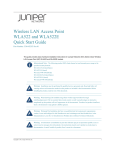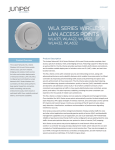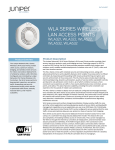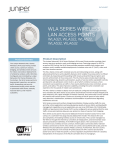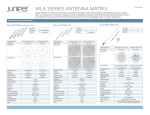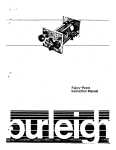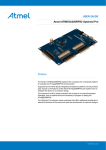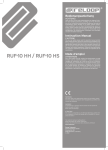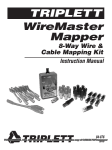Download Juniper WLA522
Transcript
Wireless LAN Access Point WLA522 and WLA522E Quick Start Guide Part Number: 530-042353 Rev.01 This guide provides basic hardware installation instructions for Juniper Networks WLA Series Indoor Wireless LAN Access Point (AP) WLA522 and WLA522E models. Informational Note: The following product SKUs limit channel set and transmit power range to the specified country/domain: WLA522-US (United States) WLA522-IL (Israel) WLA522-WW (Worldwide) WLA522E-US (United States) WLA522E-IL (Israel) WLA522E-WW (Worldwide) Warning: Installation must be performed by qualified service personnel only. Read and follow all warning notices and instructions marked on the product or included in the documentation. Before installing the product, read the rest of this document. Warning: Waarschuwing! De installatie mag alleen worden uitgevoerd door bevoegd onderhoudspersoneel. Het is essentieel dat u kennis neemt van alle waarschuwingen en instructies aangebracht op het product zelf en/of opgenomen in de documentatie. Voordat u het product installeert, dient u dit document in zijn geheel te hebben gelezen. Warning: Warnung! Die Installation darf nur von qualifiziertem Servicepersonal vorgenommen werden. Lesen und befolgen Sie alle Warnhinweise und -anleitungen auf dem Produkt bzw. in der Dokumentation. Lesen Sie vor Installation des Produkts den restlichen Teil dieses Dokuments. Warning: Avertissement! L’installation ne peut être effectuée que par un personnel qualifié. Lisez et suivez tous les messages d’avertissement et les instructions inscrits sur le produit ou inclus dans la documentation. Avant d’installer le produit, lisez le reste de ce document. Copyright © 2011, Juniper Networks, Inc. 1 Wireless LAN Access Point WLA522 and WLA522E Quick Start Guide Part Number: 530-042353 Rev.01 Warning: Attenzione! L’installazione deve essere effettuata unicamente da personale qualificato. Leggere e rispettare tutte le segnalazioni di attenzione e le istruzioni indicate sul prodotto o incluse nella documentazione. Prima d’installare il prodotto, leggere tutto il documento. Warning: ¡Advertencia! La instalación debe realizarse exclusivamente por parte de personal de servicio cualificado. Lea y siga todas las notas de advertencia e instrucciones en el producto o la documentación. Antes de instalar el producto deberá leer la parte restante del presente documento. Warning: ¡Advertencia! A instalação dever ser realizada exclusivamente por pessoal de serviço qualificado. Leia e siga todas as notas de advertência e instrucões no produto ou na documentação. Antes de instalar o produto deverá ler a parte restante do presente documento. Warning: Varning! Installation får endast utföras av kvalificerad servicepersonal. Läs och följ alla varningsmeddelanden och instruktioner markerade på produkten eller inkluderade i dokumenteringen. Innan produkten installeras skall resten av dessa dokument läsas. Warning: Advarsel! Installation må kun gennemføres af faglært servicepersonale. Læs, og følg alle de advarselsmeddelelser og anvisninger, der er anført på produktet eller i dokumentationen. Læs resten af dette dokument før installation af produktet. Warning: Advarsel! Installasjon skal kun utføres av kvalifisert service personell. Les og følg alle varsels meldinger og instrukssjons merkinger på produktet og i veiledningen. Les resten av denne veiledningen før produktet installeres. Warning: Varoitus! Installatie dient uitsluitend plaats te vinden door bevoegde monteurs. Lees alle waarschuwingen en instructies die op het product zijn aangegeven of in de documentatie zijn opgenomen, en volg deze op. Lees voordat u het product installeert eerst de rest van dit document. Warning: Viðvörun! Aðeins hæfir þjónustufulltrúar mega sinna uppsetningu tækjanna. Lesið og fylgið öllum viðvörunum og leiðbeiningum í þessum gögnum. Lesið restina af þessum gögnum fyrir uppsetningu. Warning: Προσοχή! Η εγκατάσταση πρέπει να εκτελείται μόνο από εγκεκριμένο προσωπικό συντήρησης. Διαβάστε και ακολουθείστε όλες τις προειδοποιήσεις και οδηγίες που αναγράφονται στο προϊόν ή που περιλαμβάνονται στην τεκμηρίωση. Πριν προβείτε στην εγκατάσταση 2 Copyright © 2011, Juniper Networks, Inc. Wireless LAN Access Point WLA522 and WLA522E Quick Start Guide Part Number: 530-042353 Rev.01 Warning: 경고! 공인 서비스 기사만 설치 작업을 수행할 수 있습니다. 제품에 표시되어 있거나 설명서에 포함된 모든 경고 문구 및 지침을 읽어 보시고 준수하십시오. 제품을 설치하기 전에 본 설명서를 전체적으로 읽어 보시기 바랍니다. Warning: Warning! 設置は、資格を持ったサービス要員のみが行えます。 製品に付いているあるいはドキュメントに含まれている全ての警告注意を 読み、それに従ってください。 製品を設置する前に、本ドキュメントの残りをお読みください。 Warning: 警告!安装工作只能由合格服务人员进行。 请阅读且遵照所有在产品上或者在文件内标记的警告通知、说明。 在安装产品之前,请阅读这份文件的剩余部分。 Warning: Внимание! Монтаж должен производить только квалифицированный обслуживающий персонал. Прочтите и выполняйте все предупредительные примечания и инструкции, нанесенные на изделие или включенные в документацию. Перед монтажом изделия прочтите данный документ до конца. Warning: .אזהרה! ההתקנה תתבצע על ידי טכנאי מוסמך בלבד קרא ופעל בהתאם לכל האזהרות וההוראות המסומנות . על המוצר או מופיעות בתיעוד. קרא מסמך זה במלואו,לפני התקנת המוצר Warning: For detailed compliance information see the Juniper Networks Regulatory Guide and the Juniper Networks Indoor Wireless Lan Access Point Installation Guide located at: http://www.juniper.net/. The guides can be downloaded in PDF format. Warning: Always install the four WLA522E antennas before supplying power to the AP. Failure to do so can cause damage to the unit. Warning: The operation of antenna WLA-ANT5007-OUT is not allowed in India. Copyright © 2011, Juniper Networks, Inc. 3 Wireless LAN Access Point WLA522 and WLA522E Quick Start Guide Part Number: 530-042353 Rev.01 Installing and Connecting a WLA Informational Note: Before installing an AP, you might need to generate a network plan and an AP work order with RingMaster. (See RingMaster Network Plan and Work Orders below.) Installation Requirements and Recommendations For best results, follow these requirements and recommendations before installing a WLA. RingMaster Network Plan and Work Orders If you are using RingMaster to plan your Juniper Networks Mobility System installation, you might want to create and verify a network plan for the entire Juniper Networks installation and generate an AP work order before installation. A network plan and the AP work orders generated from it provide the following information about AP installation and configuration: Number of APs required for adequate WLAN capacity in each coverage area Detailed installation location for each AP Settings for all APs in the WLAN Informational Note: System Administrators and equipment installers of the WLAN System are responsible for the proper setup and operation in accordance to all rules and regulations of the country in which the equipment operates. Wireless Lan Controller (WLC) Appliance Recommendation Juniper Networks recommends that you install and configure the WLC before installing an AP. If the WLC is already installed and configured for the APs, you can immediately verify the cable connection(s) when you plug the cable(s) into the AP. Warning: An Indoor AP is designed to receive power only from an 802.3af-compliant source, a Juniper WLC, or a Juniper Networks-approved power injector. Connecting an AP to a Power over Ethernet (PoE) device not approved by Juniper Networks can damage the equipment. Wall Installation Recommendations If you plan to install the AP on a partial wall or other vertical surface, orient the top of the AP (the side with the LEDs) toward the intended coverage area. The radio antennas transmit through the top of the AP but not through the bottom, where the bracket is located. This recommendation does not apply if you are installing the WLA522E. Orient the antennas as shown in WLA522E Installation Antenna Orientation on page 32. AP Radio Safety Advisories When you enable the AP radio(s) as part of WLC configuration, the radios can receive and transmit radio frequency energy as soon as you connect the AP to the WLC, either directly or through the network. 4 Installing and Connecting a WLA Copyright © 2011, Juniper Networks, Inc. Wireless LAN Access Point WLA522 and WLA522E Quick Start Guide Part Number: 530-042353 Rev.01 Radio Frequency Exposure Federal Communications Commission (FCC) Docket 96-8 for Spread Spectrum Transmitters specifies a safety standard for human exposure to radio frequency electromagnetic energy emitted by FCC-certified equipment. When used with Juniper-approved antennas, Juniper Networks APs meet the uncontrolled environmental limits found in OET-65 and ANSI C95.1-1991. Proper installation of the AP according to the instructions in this manual will result in user exposure that is below the FCC recommended limits. Federal Communication Commission Interference Statement This equipment has been tested and found to comply with the limits for a Class B digital device, pursuant to Part 15 of the FCC Rules. These limits are designed to provide reasonable protection against harmful interference in a residential installation. This equipment generates, uses and can radiate radio frequency energy and, if not installed and used in accordance with the instructions, may cause harmful interference to radio communications. However, there is no guarantee that interference will not occur in a particular installation. If this equipment does cause harmful interference to radio or television reception, which can be determined by turning the equipment off and on, the user is encouraged to try to correct the interference by one of the following measures: Reorient or relocate the receiving antenna. Increase the separation between the equipment and receiver. Connect the equipment into an outlet on a circuit different from that to which the receiver is connected. Consult the dealer or an experienced radio/TV technician for help. This device complies with Part 15 of the FCC Rules. Operation is subject to the following two conditions: (1) This device may not cause harmful interference, and (2) this device must accept any interference received, including interference that may cause undesired operation. Warning: FCC Caution Any changes or modifications not expressly approved by the party responsible for compliance could void the user's authority to operate this equipment. This device and its antenna(s) must not be co-located or operating in conjunction with any other antenna or transmitter. Warning: FCC and IC Radiation Exposure Statement This equipment complies with FCC and IC RSS-102 radiation exposure limits set forth for an uncontrolled environment. This equipment should be installed and operated with minimum distance 50cm (19.7 inches) between the radiator and your body. Copyright © 2011, Juniper Networks, Inc. Installing and Connecting a WLA 5 Wireless LAN Access Point WLA522 and WLA522E Quick Start Guide Part Number: 530-042353 Rev.01 Warning: FCC Notice for the WLA522E: For indoor operations: Devices will not permit operations on channels 120-132 for 11a and 11n/a which overlap the 5600 5650 MHz band. For outdoor operations: In order to meet new FCC, NTIA, FAA and industry restrictions to resolve interference to Terminal Doppler Weather Radar (TDWR) systems used at airports, any outdoor device installed within 35 km of a TDWR location must be separated by at least 30 MHz (center-to-center) from TDWR operating frequency (as shown in the table below). Channels 120-132 and 5600-5650 MHz band are disabled on any antennaes located outdoors. Warning: Juniper Networks recommends that all operators and installers register the location information of the UNII devices operating outdoors in the 5470 – 5725 MHz band within 35 km of any TDWR location at the WISPA sponsored database (http://www.spectrumbridge.com/udia/home.aspx). This database may be used by government agencies in order to expedite resolution of any interference to TDWRs. Warning: Procedures on how to register the devices in the industry-sponsored database with the appropriate information regarding the location and operation of the device and installer information can be found on the database. Table 1: TDWR Location Information Antenna 6 Terrain Height Elevation Above (MSL) [ft] Terrain [ft] State City Longitude Latitude Frequency AZ Phoenix W 112 09 46 N 33 25 14 5610 MHz 1024 64 CO Denver W 104 31 35 N 39 43 39 5615 MHz 5643 64 FL Ft. Lauderdale W 080 20 39 N 26 08 36 5645 MHz 7 113 FL Miami W 080 29 28 N 25 45 27 5605 MHz 10 113 FL Orlando W 081 19 33 N 28 20 37 5640 MHz 72 97 FL Tampa W 082 31 04 N 27 51 35 5620 MHz 14 80 FL West Palm Beach W 080 16 23 N 26 41 17 5615 MHz 20 113 GA Atlanta W 084 15 44 N 33 38 48 5615 MHz 962 113 IL McCook W 087 51 31 N 41 47 50 5615 MHz 646 97 IL Crestwood W 087 43 47 N 41 39 05 5645 MHz 663 113 IN Indianapolis W 086 29 08 N 39 38 14 5605 MHz 751 97 KS Wichita W 097 26 13 N 37 30 26 5603 MHz 1270 80 KY Covington Cincinnati W 084 34 48 N 38 553 53 5601 MHz 942 97 KY Louisville W 085 36 38 N 38 02 45 5646 MHz 617 113 LA New Orleans W 090 24 11 N 30 01 18 5645 MHz 2 97 MA Boston W 070 56 01 N 42 09 30 5610 MHz 151 113 MD Brandywine W 076 50 42 N 38 41 43 5635 MHz 233 113 MD Benfield W 076 37 48 N 39 05 23 5645 MHz 184 113 MD Clinton W 076 57 43 N 38 45 32 5615 MHz 249 97 MI Detroit W 083 30 54 N 42 06 40 5615 MHz 656 113 MN Minneapolis W 092 55 58 N 44 52 17 5610 MHz 1040 80 MO Kansas City W 094 44 31 N 39 29 55 5605 MHz 1040 64 Installing and Connecting a WLA Copyright © 2011, Juniper Networks, Inc. Wireless LAN Access Point WLA522 and WLA522E Quick Start Guide Part Number: 530-042353 Rev.01 Antenna State Terrain Height Elevation Above City Longitude Latitude Frequency (MSL) [ft] Terrain [ft] MO Saint Louis W 090 29 21 N 38 48 20 5610 MHz 551 97 MS Desoto County W 089 59 33 N 34 53 45 5610 MHz 371 113 NC Charlotte W 080 53 06 N 35 20 14 5608 MHz 757 113 NC Raleigh Durham W 078 41 50 N 36 00 07 5647 MHz 400 113 NJ Woodbridge W 074 16 13 N 40 35 37 5620 MHz 19 113 NJ Pennsauken W 075 04 12 N 39 56 57 5610 MHz 39 113 NV Las Vegas W 115 00 26 N 36 08 37 5645 MHz 1995 64 NY Floyd Bennett Field W 073 52 49 N 40 35 20 5647 MHz 8 97 OH Dayton W 084 07 23 N 40 01 19 5640 MHz 922 97 OH Cleveland W 082 00 28 N 41 17 23 5645 MHz 817 113 OH Columbus W 082 42 55 N 40 00 20 5605 MHz 1037 113 OK Aero. Ctr TDWR #1 W 097 37 31 N 35 24 19 5610 MHz 1285 80 OK Aero. Ctr TDWR #2 W 097 37 43 N 35 23 34 5620 MHz 1293 97 OK Tulsa W 095 49 34 N 36 04 14 5605 MHz 712 113 OK Oklahoma City W 097 30 36 N 35 16 34 5603 MHz 1195 64 PA Hanover W 080 29 10 N 40 30 05 5615 MHz 1266 113 PR San Juan W 066 10 46 N 18 28 26 5610 MHz 59 113 TN Nashville W 086 39 42 N 35 58 47 5605 MHz 722 97 TX Houston Intercontinental W 095 34 01 N 30 03 54 5605 MHz 154 97 TX Pearland W 095 14 30 N 29 30 59 5645 MHz 36 80 MN Minneapolis W 092 55 58 N 44 52 17 5610 MHz 1040 80 MO Kansas City W 094 44 31 N 39 29 55 5605 MHz 1040 64 MO Saint Louis W 090 29 21 N 38 48 20 5610 MHz 551 97 MS Desoto County W 089 59 33 N 34 53 45 5610 MHz 371 113 NC Charlotte W 080 53 06 N 35 20 14 5608 MHz 757 113 NC Raleigh Durham W 078 41 50 N 36 00 07 5647 MHz 400 113 NJ Woodbridge W 074 16 13 N 40 35 37 5620 MHz 19 113 NJ Pennsauken W 075 04 12 N 39 56 57 5610 MHz 39 113 NV Las Vegas W 115 00 26 N 36 08 37 5645 MHz 1995 64 NY Floyd Bennett Field W 073 52 49 N 40 35 20 5647 MHz 8 97 OH Dayton W 084 07 23 N 40 01 19 5640 MHz 922 97 OH Cleveland W 082 00 28 N 41 17 23 5645 MHz 817 113 OH Columbus W 082 42 55 N 40 00 20 5605 MHz 1037 113 OK Aero. Ctr TDWR #1 W 097 37 31 N 35 24 19 5610 MHz 1285 80 OK Aero. Ctr TDWR #2 W 097 37 43 N 35 23 34 5620 MHz 1293 97 OK Tulsa W 095 49 34 N 36 04 14 5605 MHz 712 113 OK Oklahoma City W 097 30 36 N 35 16 34 5603 MHz 1195 64 PA Hanover W 080 29 10 N 40 30 05 5615 MHz 1266 113 PR San Juan W 066 10 46 N 18 28 26 5610 MHz 59 113 TN Nashville W 086 39 42 N 35 58 47 5605 MHz 722 97 Copyright © 2011, Juniper Networks, Inc. Installing and Connecting a WLA 7 Wireless LAN Access Point WLA522 and WLA522E Quick Start Guide Part Number: 530-042353 Rev.01 Antenna State City Longitude TX Houston Intercontinental TX Pearland Terrain Height Elevation Above Latitude Frequency (MSL) [ft] Terrain [ft] W 095 34 01 N 30 03 54 5605 MHz 154 97 W 095 14 30 N 29 30 59 5645 MHz 36 80 Warning: FCC Caution for the WLA522E To comply with FCC part 15 rules in the United States, the system must be professionally installed to ensure compliance with the Part 15 certification. It is the responsibility of the operator and professional installer to ensure that only certified systems are deployed in the United States. The use of the system in any other combination (such as co-located antennas transmitting the same information) is expressly forbidden. The device could automatically discontinue transmission in case of absence of information to transmit, or operational failure. Note that this is not intended to prohibit transmission of control or signaling information or the use of repetitive codes where required by the technology. The device for the band 5150-5250 MHz is only for indoor usage to reduce potential for harmful interference to co-channel mobile satellite systems. The maximum antenna gain permitted (for devices in the bands 5250-5350 MHz and 5470-5725 MHz) to comply with the e.i.r.p. limit. The maximum antenna gain permitted (for devices in the band 5725-5825 MHz) to comply with the e.i.r.p. limits specified for point-to-point and non point-to-point operation as appropriate, as stated in section A9.2(3). High-power radars are allocated as primary users (meaning they have priority) of the bands 5250-5350 MHz and 5650-5850 MHz and these radars could cause interference and/or damage to LE-LAN devices. Warning: IC Statement for the WLA522E- This Class B digital apparatus complies with Canadian ICES-003. Operation is subject to the following two conditions: (1) this device may not cause interference, and (2) this device must accept any interference, including interference that may cause undesired operation of the device. Warning: Cet appareil numérique de la classe B est conforme á la norme NMB-003 du Canada. 8 Installing and Connecting a WLA Copyright © 2011, Juniper Networks, Inc. Wireless LAN Access Point WLA522 and WLA522E Quick Start Guide Part Number: 530-042353 Rev.01 Additional Radio Safety Advisories Warning: In the U.S., locate the AP and any externally attached antennas a minimum of 50cm (19.7 inches) away from people. This safety warning conforms with FCC radio frequency exposure limits for dipole antennas such as those used in the AP. Warning: Do not operate the AP near unshielded blasting caps or in an otherwise explosive environment unless the device has been modified for such use by qualified personnel. Warning: Before using a wireless device in a hazardous location, consult the local codes, national codes, and safety directors of the location for usage constraints. Warning: Do not touch or move the AP when the antennas are transmitting or receiving. Warning: Do not hold any radio device so that the antenna is very close to or touching the face, eyes, or other exposed body part while the radio antenna is transmitting. Cabling Requirements Warning: Do not connect or disconnect cables or otherwise work with the AP hardware during periods of lightning activity. Informational Note: The AP is intended for indoor use only. Do not install the device outdoors, unless you install it with a Juniper Networks outdoor AP enclosure. Informational Note: To reduce the possibility of connection interference caused by dust, clean the Cat 5 connector pins before inserting a cable into an AP. Category 5 cable with straight-through signaling must be installed at the site before you install an AP. A single connection requires one cable. A dual-homed connection requires two cables. Mounting an AP on a solid surface requires Cat 5 cable that does not have strain relief. For installation on all other surfaces, use a Cat 5 cable with or without strain relief. Copyright © 2011, Juniper Networks, Inc. Installing and Connecting a WLA 9 Wireless LAN Access Point WLA522 and WLA522E Quick Start Guide Part Number: 530-042353 Rev.01 Installing an Indoor AP Installation Hardware and Tools The table below lists the mounting hardware and tools required for AP installation. Table 2: Required Mounting Hardware and Tools Included with the Mounting Option Required Hardware and Tools Product Suspended ceiling—flush ceiling tiles Mounting template Yes Universal mounting bracket Yes T-bar clamp — A T-bar clamp is not required for a Yes 23.9-millimeter (15/16-inch) T-bar ceiling with flush ceiling tiles. Suspended ceiling—drop ceiling tiles Junction box Solid wall or ceiling Tabletop Box cutter No Small screwdriver (3-millimeter or 1/8-inch) No small-pointed instrument or a paperclip No Mounting template Yes Universal mounting bracket Yes T-bar clamp Yes Box cutter No Small screwdriver (3-millimeter or 1/8-inch) No small-pointed instrument or a paperclip No Junction box No Two #6-32 x 1-inch machine screws Yes Universal mounting bracket Yes Small screwdriver (3-millimeter or 1/8-inch) No #2 Phillips-head screwdriver No small-pointed instrument or a paperclip No Two #6 sheet metal screws and two drywall anchors Yes Universal mounting bracket Yes Hammer No Small screwdriver (3-millimeter or 1/8-inch) No #2 Phillips-head screwdriver No small-pointed instrument or a paperclip No Universal mounting bracket Yes Small screwdriver (3-millimeter or 1/8-inch) No small-pointed instrument or a paperclip No Informational Note: Indoor APs are UL2043 plenum rated, so it also can be installed in the space above the ceiling if preferred. 10 Installing an Indoor AP Copyright © 2011, Juniper Networks, Inc. Wireless LAN Access Point WLA522 and WLA522E Quick Start Guide Part Number: 530-042353 Rev.01 Installing an Indoor WLA522 Suspended Ceiling Installation — Flush Ceiling Tiles for the WLA522 1. Select an installation location centered over a T-bar in the ceiling. 2. Cut a hole as follows in the ceiling tile for the Cat 5 cable: 3. 4. a. Place the mounting template over the area where you plan to install the AP. b. Use the box cutter to cut along the line marking the opening for the port connectors. c. Remove the mounting template and the material you cut from the ceiling panel. Determine whether to install a T-bar clamp onto the ceiling T-bar: a. If the T-bar width is 14.2 millimeter (9/16 inches), you need to install the 14.2-millimeter (9/16 inches) T-bar clamp. Go to step 4. b. If the T-bar width is 23.9 millimeter (15/16 inches), the universal mounting bracket fits directly onto the T-bar. Go to step 5. Install the 14.2-millimeter (9/16-inch) T-bar clamp onto the ceiling T-bar as shown in Figure 1. a. Slide each half of the clamp onto the T-bar so that the clamp lip is fully on the T-bar. b. Slide the two halves of the clamp toward each other until the tabs are inserted completely into the holes and the clamp fits snugly on the T-bar. Figure 1: Step 4—Installing a T-bar Clamp T-bar Slide together T-bar clamp halves 5. Unlock the universal mounting bracket from the AP by inserting the lock/unlock tool into the Unlock hole on the AP as shown in Figure 2 below. Caution: Use a small-pointed instrument or a paperclip to unlock the AP. Do not use a screwdriver because it may cause damage to the AP lock mechanism or electronic components. Do not use excessive force when inserting a tool into the Unlock or Lock hole. Copyright © 2011, Juniper Networks, Inc. Installing an Indoor WLA522 11 Wireless LAN Access Point WLA522 and WLA522E Quick Start Guide Part Number: 530-042353 Rev.01 Figure 2: Step 5—Unlocking the Bracket 6. Remove the bracket as shown in Figure 3 below. Figure 3: Step 6—Removing the Bracket 7. Install the universal mounting bracket as follows onto the T-bar or T-bar clamp. a. 12 Installing an Indoor WLA522 As shown in the Figure 4 below, place the universal mounting bracket against the T-bar or clamp so that the two screw holes face downward and the two T-bar flanges face upward and are adjacent to the T-bar edges. Copyright © 2011, Juniper Networks, Inc. Wireless LAN Access Point WLA522 and WLA522E Quick Start Guide Part Number: 530-042353 Rev.01 Figure 4: Step 7—Top View Universal mounting bracket T-bar Port connector opening b. Properly align the bracket for mounting by placing the bracket so the port connector opening is to the left of the hole you cut for the cables. c. Rotate the universal mounting bracket clockwise until the flanges snap into place on the T-bar or clamp as shown in Figure 5 below. Figure 5: Step 7—Bottom View Port connector opening Universal mounting bracket T-bar Copyright © 2011, Juniper Networks, Inc. Installing an Indoor WLA522 13 Wireless LAN Access Point WLA522 and WLA522E Quick Start Guide Part Number: 530-042353 Rev.01 Informational Note: WLA522-Specific Optional Earthquake Safety Step At this point, once you have the T-bar installed and the universal mounting bracket snapped into place, you have the option of securing the bracket for earthquake safety using the two supplied M3 pan head threaded screws. Informational Note: Note that the T-bars and the universal mounting bracket in the WLA522 Installation Kit have two additional screw holes as shown below. When the universal mounting bracket is snapped into place, the holes will align. Screw the two M3 pan head threaded screws into the holes. The screws will hold the T-bar and universal mounting bracket together in the event of an earthquake. The WLA522 is then locked securely into place on the secured universal mounting bracket. M3 pan head screw M3 pan head screw 8. Pull the Cat 5 cable about 15 centimeters (about 6 inches) out of the hole in the ceiling tile and through the port connector opening to create enough slack to insert the cable. 9. Insert the Cat 5 cable into the connector. 10. Install the Kensington lock, if you plan to use one. 14 Installing an Indoor WLA522 Copyright © 2011, Juniper Networks, Inc. Wireless LAN Access Point WLA522 and WLA522E Quick Start Guide Part Number: 530-042353 Rev.01 a. Loop the Kensington lock cable around an object that cannot be moved or damaged by a person pulling on the cable. b. Insert the key into the Kensington lock. c. Insert the Kensington lock into the security slot on the AP. d. Rotate the key right or left to secure the lock to the AP. e. Pull on the lock to verify that it is secured to the AP. f. Remove the key. 11. Lift the AP into place on the universal mounting bracket as shown in Figure 6 below. Make sure the cable feeds properly into the ceiling as you lift the device, and does not become trapped between the AP and the bracket. Figure 6: Step 10—Placing the AP on the Bracket 12. Lock the AP onto the bracket by inserting a small-pointed instrument or a paperclip into the Lock hole on the AP as shown in Figure 7 below. Warning: To prevent possible damage to the AP, make sure the device is fully locked onto the bracket before releasing it. Copyright © 2011, Juniper Networks, Inc. Installing an Indoor WLA522 15 Wireless LAN Access Point WLA522 and WLA522E Quick Start Guide Part Number: 530-042353 Rev.01 Figure 7: Step 12—Locking the Bracket Lock 13. To ensure that the AP is fully locked onto the bracket, gently pull down on the AP and attempt to rotate it from side to side. 14. If the AP comes off the bracket, relock the device onto the bracket as described in step 12. 15. If the AP requires an external antenna, install and connect the antenna. Suspended Ceiling Installation—Drop Ceiling Tiles 1. Select an installation location that is centered over a T-bar in the ceiling. 2. Cut a hole as follows in the ceiling tile for the Cat 5 cable: 3. 16 a. Place the mounting template over the area where you plan to install the AP. b. Use the box cutter to cut along the line marking the opening for the port connectors. c. Remove the mounting template and the material you cut from the ceiling panel. Install the T-bar clamp that fits the T-bar: a. Slide each half of the clamp onto the T-bar so that the clamp lip is fully on the T-bar. b. Slide the two halves of the clamp toward each other until the tabs are inserted completely into the holes and the clamp fits snugly on the T-bar. Installing an Indoor WLA522 Copyright © 2011, Juniper Networks, Inc. Wireless LAN Access Point WLA522 and WLA522E Quick Start Guide Part Number: 530-042353 Rev.01 Figure 8: Step 3—Installing the T-bar Clamp for a 23.9-millimeter (15/16-inch) T-bar T-bar Slide together T-bar clamp halves Figure 9: Step 3—Installing the T-bar Clamp for a 15.9-millimeter (5/8-inch) T-bar T-bar Slide together T-bar clamp halves 4. Unlock the universal mounting bracket from the AP by inserting a small-pointed instrument or a paperclip into the Unlock hole on the AP as shown in Figure 10 below. Caution: Use a small-pointed instrument or a paperclip to unlock the AP. Do not use a screwdriver because it may cause damage to the AP lock mechanism or electronic components. Do not use excessive force when inserting a tool into the Unlock or Lock hole. Copyright © 2011, Juniper Networks, Inc. Installing an Indoor WLA522 17 Wireless LAN Access Point WLA522 and WLA522E Quick Start Guide Part Number: 530-042353 Rev.01 Figure 10: Step 4—Unlocking the Bracket 5. Remove the bracket as shown in Figure 11 below. Figure 11: Step 5—Removing the Bracket 6. 18 Install the universal mounting bracket as follows onto the T-bar clamp: a. As shown in Figure 12, place the universal mounting bracket against the T-bar clamp so that the two screw holes face downward and the two T-bar flanges face upward and are adjacent to the T-bar edges. b. Properly align the bracket for mounting by placing the bracket so that the port connector opening is to the left of the hole you cut for the cables. c. Rotate the universal mounting bracket clockwise until the flanges snap into place on the T-bar clamp as shown below. Installing an Indoor WLA522 Copyright © 2011, Juniper Networks, Inc. Wireless LAN Access Point WLA522 and WLA522E Quick Start Guide Part Number: 530-042353 Rev.01 Figure 12: Step 6—Top View Universal mounting bracket T- bar T-bar clamps (attached to T-bar) Port connector opening (Viewed from above ceiling tiles, looking down.) Figure 13: Step 6—Bottom View Port connector opening Universal mounting bracket T-bar 7. Pull the Cat 5 cable about 15 centimeters (about 6 inches) out of the hole in the ceiling tile and through the port connector opening to create enough slack to insert the cable. 8. Insert the Cat 5 cable into the connector. 9. Install the Kensington lock, if you plan to use one. a. Loop the Kensington lock cable around an object that cannot be moved or damaged by a person pulling on the cable. b. Insert the key into the Kensington lock. c. Insert the Kensington lock into the security slot on the AP. d. Rotate the key right or left to secure the lock to the AP. e. Pull on the lock to verify that it is secured to the AP. f. Remove the key. Copyright © 2011, Juniper Networks, Inc. Installing an Indoor WLA522 19 Wireless LAN Access Point WLA522 and WLA522E Quick Start Guide Part Number: 530-042353 Rev.01 10. Lift the AP into place on the universal mounting bracket as shown in Figure 14. Make sure the cable feeds properly into the ceiling as you lift the device, and does not become trapped between the AP and the bracket. Figure 14: Step 9—Placing the AP on the Bracket 11. Lock the AP onto the bracket by inserting a small-pointed instrument or a paperclip into the Lock hole on the AP as shown in Figure 15 below. Warning: To prevent possible damage to the AP, make sure the device is fully locked onto the bracket before releasing it. Figure 15: Step 10—Locking the Bracket 12. To ensure that the AP is fully locked onto the bracket, gently pull down on the AP and attempt to rotate it from side to side. 13. If the AP comes off the bracket, relock the device onto the bracket. 14. If the AP requires an external antenna, install and connect the antenna. 20 Installing an Indoor WLA522 Copyright © 2011, Juniper Networks, Inc. Wireless LAN Access Point WLA522 and WLA522E Quick Start Guide Part Number: 530-042353 Rev.01 Junction Box Installation 1. Unlock the universal mounting bracket from the AP by inserting a small-pointed instrument or a paperclip into the Unlock hole on the AP as shown in Figure 16. Warning: Use a lock/unlock tool to unlock the AP. Do not use a screwdriver because it may cause damage to the AP lock mechanism or electronic components. Do not use excessive force when inserting a tool into the Unlock or Lock hole. Figure 16: Step 1—Unlocking the Bracket 2. Remove the bracket as shown in Figure 17. Figure 17: Step 2—Removing the Bracket 3. Attach the universal mounting bracket to the junction box as shown in Figure 18: a. Place the universal mounting bracket against the junction box so that the two screw holes face the junction box and align over the screw holes in the box. b. Insert the #6-32 x 1-inch machine screws in the universal mounting bracket screw holes, and use a #2 Phillips-head screwdriver to tighten them. Copyright © 2011, Juniper Networks, Inc. Installing an Indoor WLA522 21 Wireless LAN Access Point WLA522 and WLA522E Quick Start Guide Part Number: 530-042353 Rev.01 Figure 18: Step 3—Placing the Bracket on the Junction Box Junction box Port connector opening 4. Pull the Cat 5 cable about 15 centimeters (about 6 inches) out of the junction box and through the port connector opening to create enough slack to insert the cable into the port connectors. 5. Insert the Cat 5 cable into the connector. 6. Install the Kensington lock, if you plan to use one. a. Loop the Kensington lock cable around an object that cannot be moved or damaged by a person pulling on the cable. b. Insert the key into the Kensington lock. c. Insert the Kensington lock into the security slot on the AP. d. Rotate the key right or left to secure the lock to the AP. e. Pull on the lock to verify that it is secured to the AP. f. Remove the key. 7. Lift the AP into place on the universal mounting bracket. Make sure the cable feeds properly into the junction box as you lift the device, and does not become trapped between the AP and the bracket. 8. Lock the AP onto the bracket by inserting a small-pointed instrument or a paperclip into the Lock hole on the AP as shown in Figure 19. Warning: To prevent possible damage to the AP, make sure the device is fully locked onto the bracket before releasing it. 22 Installing an Indoor WLA522 Copyright © 2011, Juniper Networks, Inc. Wireless LAN Access Point WLA522 and WLA522E Quick Start Guide Part Number: 530-042353 Rev.01 Figure 19: Step 7—Locking the Bracket Lock 9. To ensure that the AP is fully locked onto the bracket, gently pull down on the AP and attempt to rotate it from side to side. 10. If the AP comes off the bracket, relock the device onto the bracket. 11. If the AP requires an external antenna, install and connect the antenna. Solid Wall or Ceiling Installation Informational Note: The solid surface mounting option requires Cat 5 cable that does not have strain relief, unless you plan to route the cable through a hole in the wall or ceiling. The other options can use Cat 5 cable with or without strain relief. 1. Prepare holes in the wall or ceiling for the universal mounting bracket, using the following steps: a. Place the paper mounting template over the location to install the AP. b. Mark the screw hole location(s). c. If you plan to route the Cat 5 cable externally along the wall or ceiling, mark the locations of both the center screw hole and the screw hole by the port connector opening. d. If you plan to route the Cat 5 cable through a hole in the wall or ceiling, mark the location of the center screw hole only. You cannot use the screw hole by the port connector opening if you cut a hole for the opening. Informational Note: Do not mark the four holes on the edges of the bracket. The AP fits into these holes. They are not screw holes. e. 2. Remove the template. Install the drywall anchor(s): a. Hammer a drywall anchor into each hole, up to the beginning of the threads on the anchor. b. Screw each anchor the rest of the way into the hole using a #2 Phillips-head screwdriver. Copyright © 2011, Juniper Networks, Inc. Installing an Indoor WLA522 23 Wireless LAN Access Point WLA522 and WLA522E Quick Start Guide Part Number: 530-042353 Rev.01 c. 3. Remove the screw from each anchor and save the screw(s) for step 6. Unlock the universal mounting bracket from the AP by inserting the lock/unlock tool into the Unlock hole on the AP as shown below. Caution: Use the lock/unlock tool to unlock the AP. Do not use a screwdriver because it may cause damage to the AP lock mechanism or electronic components. Do not use excessive force when inserting a tool into the Unlock or Lock hole. Figure 20: Step 3—Unlocking the Bracket 4. Remove the bracket as shown in Figure 21. Figure 21: Step 4—Removing the Bracket 5. 24 As shown in Figure 22, feed the Cat 5 cable through the port connector opening and align the universal mounting bracket over the drywall anchors so that the two screw holes in the bracket face the drywall anchors. Installing an Indoor WLA522 Copyright © 2011, Juniper Networks, Inc. Wireless LAN Access Point WLA522 and WLA522E Quick Start Guide Part Number: 530-042353 Rev.01 6. Insert the #6 sheet metal screws into the screw holes, and tighten them to secure the universal mounting bracket to the wall or ceiling. If you routed the Cat 5 cable through a hole in the wall or ceiling, insert the screw into the center screw hole only. Informational Note: Do not insert screws in the four holes on the edges of the bracket. The AP fits into these holes. They are not screw holes Figure 22: Steps 5 and 6—Bracket Placement on Solid Wall or Ceiling 7. Insert the Cat 5 cable into the connector. 8. Install the Kensington lock, if you plan to use one. 9. a. Loop the Kensington lock cable around an object that cannot be moved or damaged by a person pulling on the cable. b. Insert the key into the Kensington lock. c. Insert the Kensington lock into the security slot on the AP. d. Rotate the key right or left to secure the lock to the AP. e. Pull on the lock to verify that it is secured to the AP. f. Remove the key. As shown in Figure 23, place the AP on the bracket, making sure to remove any slack that occurs in the cable between the bracket and the AP. Copyright © 2011, Juniper Networks, Inc. Installing an Indoor WLA522 25 Wireless LAN Access Point WLA522 and WLA522E Quick Start Guide Part Number: 530-042353 Rev.01 Figure 23: Step 8—Cable Placement Cable Universal mounting bracket 10. Lock the AP onto the bracket by inserting the lock/unlock tool into the Lock hole on the AP as shown below. Warning: To prevent possible damage to the AP, make sure the device is fully locked onto the bracket before releasing it. Figure 24: Step 9—Locking the Bracket Lock 11. To ensure that the AP is fully locked onto the bracket, gently pull on the AP and attempt to rotate it from side to side. 12. If the AP comes off the bracket, relock the device onto the bracket. 13. If the AP requires an external antenna, install and connect the antenna. 26 Installing an Indoor WLA522 Copyright © 2011, Juniper Networks, Inc. Wireless LAN Access Point WLA522 and WLA522E Quick Start Guide Part Number: 530-042353 Rev.01 Tabletop Installation 1. Reverse the universal mounting bracket: a. Unlock the universal mounting bracket from the AP by inserting the lock/unlock tool into the Unlock hole on the AP as shown in Figure 25 below. Caution: Use the lock/unlock tool to unlock the AP. Do not use a screwdriver because it may cause damage to the AP lock mechanism or electronic components. Do not use excessive force when inserting a tool into the Unlock or Lock hole. Figure 25: Step 1a—Unlocking the Bracket b. Remove the bracket as shown in Figure 26 below. Figure 26: Step 1b—Removing the Bracket c. Turn over the universal mounting bracket, then align the bracket over the cable ports and the four mounting posts as shown in Figure 27 below. Copyright © 2011, Juniper Networks, Inc. Installing an Indoor WLA522 27 Wireless LAN Access Point WLA522 and WLA522E Quick Start Guide Part Number: 530-042353 Rev.01 Figure 27: Step 1c—Turning Over the Bracket d. Once the bracket is fully seated, lock the bracket onto the AP by inserting the lock/unlock tool into the Lock hole on the AP as shown in Figure 28 below. Figure 28: Step 1d—Locking the Bracket Lock 28 2. Insert the Cat 5 cable into the connector. 3. Install the Kensington lock, if you plan to use one. a. Loop the Kensington lock cable around an object that cannot be moved or damaged by a person pulling on the cable. b. Insert the key into the Kensington lock. c. Insert the Kensington lock into the security slot on the AP. d. Rotate the key right or left to secure the lock to the AP. e. Pull on the lock to verify that it is secured to the AP. f. Remove the key. 4. Place the AP in the desired location on the table. 5. If the AP requires an external antenna, install and connect the antenna. Installing an Indoor WLA522 Copyright © 2011, Juniper Networks, Inc. Wireless LAN Access Point WLA522 and WLA522E Quick Start Guide Part Number: 530-042353 Rev.01 Connecting an AP to an External Antenna Each radio on an Indoor AP can use an optional Juniper Networks external antenna. To mount the antenna, see the instructions that come with the antenna. To connect a mounted external antenna to an AP: 1. Attach the exterior antenna cable that is shipped with the antenna to the AP external antenna connector. Both connectors are labeled to indicate the radio type. The AP has RP-SMA connectors for attachment to the 802.11b/g antenna and to the 802.11a antenna. Caution: The external connectors on the AP are labeled: 11B/G and 11A (excluding the WLA522E which has numbered ports only). Each connector is a RP-SMA connector. Make sure you attach the antenna to the correct connector. Informational Note: If the AP is installed in a Juniper Networks outdoor AP enclosure, attach the antenna cable to the lightning surge arrestor (if installed) or the RP-SMA bulkhead connector on the enclosure. 2. Attach the other end of the antenna cable to the antenna. Radiation Patterns of Internal Antennas for 2.4-GHz and 5-GHz Radios in the WLA522 Access Point The WLA522 access point has four internal, multiple-input multiple-output (MIMO) antennas, with two antennas for each of the access point's two radios. The antennas support spatial and pattern diversity as well as cross-chain and cross-band isolations for maximum performance. The antennas provide a maximum gain of 3.4-dBi at 2.4GHz throughput and 5.6-dBi at 5GHz throughput. This topic provides graphical depictions of radiation patterns for the internal antennas. The graphics display relative field strengths of signals transmitted from or received by the antennas. You can use this radiation pattern information to determine the distance between access point and client and also where to place the access points. The figure below shows the locations of the four internal antennas within the WLA522. The antennas are numbered 1 and 5 for 5GHz elements and 2 and 6 for 2.4GHz elements. Figure 29: Internal Antennas of the WLA522 Access Point Copyright © 2011, Juniper Networks, Inc. Radiation Patterns of Internal Antennas for 2.4-GHz and 5-GHz Radios in the WLA522 Access Point 29 Wireless LAN Access Point WLA522 and WLA522E Quick Start Guide Part Number: 530-042353 Rev.01 The figure below shows the horizontal-plane radiation patterns for the access point. The pattern provides even and complete 360-degree coverage by the antenna elements. Figure 30: Horizontal-Plane Radiation Patterns (Omni-directional) for a Ceiling-Mounted WLA522 Access Point. 30 Radiation Patterns of Internal Antennas for 2.4-GHz and 5-GHz Radios in the WLA522 Access Point Copyright © 2011, Juniper Networks, Inc. Wireless LAN Access Point WLA522 and WLA522E Quick Start Guide Part Number: 530-042353 Rev.01 The figure below shows the inverted vertical plane radiation patterns for the access point. The pattern provides maximum antenna gains along the outer edges of the access point with a 30-degree downtilt. Figure 31: The Inverted (Pointing at the Ground at a 0-Degree Angle) Vertical-Plane Radiation Patterns for a Ceiling-Mounted WLA522 Access Point. Copyright © 2011, Juniper Networks, Inc. Radiation Patterns of Internal Antennas for 2.4-GHz and 5-GHz Radios in the WLA522 Access Point 31 Wireless LAN Access Point WLA522 and WLA522E Quick Start Guide Part Number: 530-042353 Rev.01 Installing an Indoor WLA522E Access Point The WLA522E installation steps for ceiling or wall mount are the same as the WLA522 except that you must install and orient the four antennas on the AP before supplying power to the unit. The WLA522E has no internal antennas and requires antennas for all types of operation. Once the AP is installed on either the wall or ceiling with antennas attached you can switch between Radio 1 and 2 using the CLI command: set ap # radio x mode disable Warning: Always install the four WLA522E antennas before supplying power to the AP. Failure to do so can cause damage to the unit. Warning: The tested/certified antennas are equipped with Reverse-SMA or N-type jacks. Warning: This device and its antenna(s) must not be co-located or operated in conjunction with any other antenna or transmitter. Warning: The external connectors on the WLA522E are labeled 1, 2, 3, 6 on the housing. Each connector is a RP-SMA connector. Make sure you attach the antenna to the correct connector. Warning: For products available in the USA/Canada market, only channel 1~11 can be operated. Selection of other channels is not possible. Warning: This device is going to be operated in 5.15~5.25GHz frequency range, it is restricted in indoor environment only. WLA522E Installation Antenna Orientation Adjust the WLA522E antennas as shown below for optimal polarization. Warning: Always turn the paddle antenna clockwise while adjusting the antenna orientation in order to prevent loosening of the connector. Figure 32: Wall Mount Radio port 3 11A Radio port 2 11B/G 32 Installing an Indoor WLA522E Access Point Radio port 6 11A Radio port 1 11B/G Copyright © 2011, Juniper Networks, Inc. Wireless LAN Access Point WLA522 and WLA522E Quick Start Guide Part Number: 530-042353 Rev.01 Figure 33: Ceiling Mount Connecting an AP to an WLC You can connect an AP directly to an WLC or indirectly to the WLC through an intermediate Layer 2 or Layer 3 network. If you are connecting the AP directly to an WLC, use the following procedure to insert the cable into the WLC and verify the link. You can use the CLI or RingMaster to configure an AP connection. If you are installing the AP as a Mesh AP in a WLAN Mesh or wireless bridge configuration, you must configure the AP connection before deploying the AP in the final location. (See the Mobility System Software Configuration Guide.) Figure 31 below shows how to insert a Cat 5 cable into 10/100 Ethernet port on an WLC. Refer to this figure as you perform the procedure. Figure 34: 10/100 Cat 5 Cable Installation Ethernet port ange y Exch Mobilit MX-20 Ethernet cable (Cat 5 cable) 1. AP, WLC, server or other device Insert a Cat 5 cable with a standard RJ-45 connector. For connection to an AP, use a straight-through cable. Copyright © 2011, Juniper Networks, Inc. Connecting an AP to an WLC 33 Wireless LAN Access Point WLA522 and WLA522E Quick Start Guide Part Number: 530-042353 Rev.01 2. 34 When the link is activated, observe the AP LED for the port on the WLC. Connecting an AP to an WLC Copyright © 2011, Juniper Networks, Inc. Wireless LAN Access Point WLA522 and WLA522E Quick Start Guide Part Number: 530-042353 Rev.01 Configuring the AP To configure the channels, power settings, and other AP parameters, see the following guide: Juniper Networks Mobility System Software Quick Start Guide External Antenna Connectors Table 3 below lists the Juniper Networks-supported WLA522E external antenna models. Table 3: Juniper Networks External Antenna Models WLA522E Model Description WLA-ANT5007-OUT Outdoor two-element cross-polarized high-gain directional panel antenna for 11n 5 WLA-ANT7360A-OUT 360° outdoor dual-band omni-directional antenna with 6 dB (8 dB) gain in the 2.4 GHz GHz band. (5 GHz) band; includes mast mounting kit and 36” Type N male to Type N male low-loss cable. WLA-ANT74520-OUT Indoor/outdoor dual-band three-element directional panel antenna for 11n. 10.9 dB (13.5 dB) gain in the 2.4 GHz (5 GHz) band and 45 degree (20 degree) horizontal beamwidth in the 2.4 GHz (5 GHz) band. WLA-ANT77555-OUT Indoor/outdoor dual-band three-element directional panel antenna for 11n, 8 dB (10.7 dB) gain in the 2.4 GHz (5 GHz) band and 75 degree (55 degree) horizontal beamwidth in the 2.4 GHz (5 Hz) band. WLA-ANTXTEND-OUT 12" Belden 7806A cable (LMR-195) with N-female and RP-SMA plug connectors for extending WLA522E coaxial interface for use with external antennas. Informational Note: The Indoor AP radios are certified for use only with these external antennas. Copyright © 2011, Juniper Networks, Inc. Configuring the AP 35



































